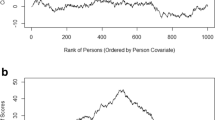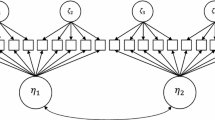Abstract
Residuals for check of model fit in the polytomous Rasch model are examined. Comparisons are made between using counts for all response pattern and using item totals for score groups for the construction of the residuals. Comparisons are also, for the residuals based on score group totals, made between using as basis the item totals, or using the estimated item parameters. The developed methods are illustrated by two examples, one from a psychiatric rating scale, one from a Danish Welfare Study.
Similar content being viewed by others
References
Andersen, E. B. (1972). The numerical solution of a set of conditional estimation equations.Journal of the Royal Statistical Society, Series B, 34, 42–54.
Andersen, E. B. (1973a). A goodness of fit test for the Rasch model.Psychometrika, 38, 123–140.
Andersen, E. B. (1973b). Conditional inference and multiple-choice questionnaires.The British Journal of Mathematical and Statistical Psychology.26, 31–44.
Andersen, E. B. (1973c).Conditional inference and models for measuring. Copenhagen: Mentalhygiejnisk Forlag.
Andersen, E. B. (1977). Sufficient statistics and latent trait models.Psychometrika, 42, 69–81.
Andrich, D. (1978). A rating formulation for ordered response categories.Psychometrika, 43, 561–573.
Bech, P. (1990). Methodological problems in assessing quality of life as outcome in psychopharmacology: A multiaxial approach. In Benkert, O. Benkert, W. Maier, and K. Rickels (Eds.),Methodology of the evaluation of psychotropic drugs. Berlin-Heidelberg: Springer-Verlag.
Bech, P., Allerup, P., et al. (1992). The Hamilton scale and the Hopkins Symptom Checklist (SCL-90): A cross-national validity study in patients with panic disorders.British Journal of Psychiatry, 160, 206–211.
Bishop, Y. M. M., Fienberg, S. E., & Holland, P. W. (1975),Discrete multivariate analysis. Theory and practice. Cambridge: The MIT Press.
Derogatis, L. R. et al. (1974). The Hopkins Symptom Checklist (HSCL). In: P. Pichot (Ed.),Psychological measurement in psychopharmacology (pp. 79–110). Basel: Karger.
Glas, C. A. W. (1988). The derivation of some tests for the Rasch model from the multinomial distribution.Psychometrika, 53, 525–546.
Glas, C. A. W. (1989).Contributions to estimating and testing Rasch models. Arnhem: Cito.
Glas, C. A. W., & Verhelst, N. D. (1989). Extensions of the partial credit model.Psychometrika, 54, 635–659.
Hansen, E. J. (1978).The distribution of living conditions. Main results from the welfare survey. Copenhagen: Teknisk Forlag. (In Danish. Danish National Institute for Social Research. Publication 82).
Molenaar, I. W. (1983). Some improved diagnostics for failure of the Rasch model.Psychometrika, 48, 49–72.
Rasch, G. (1961). On general laws and the meaning of measurement in psychology.Proceedings of the Fourth Berkeley Symposium on Mathematics, Statistics and Probability, 5, 321–333.
Rao, C. R. (1973). Linear statistical inference and its applications (2nd ed.). New York. John Wiley and Sons.
Tjur, T. (1982). A connection between Rasch's item analysis model and a multiplicative Poisson model.Scandinavian Journal of Statistics, 9, 23–30.
van den Wollenberg, A. L. (1982). Two new test statistics for the Rasch model.Psychometrika, 47, 123–140.
Author information
Authors and Affiliations
Rights and permissions
About this article
Cite this article
Andersen, E.B. Residualanalysis in the polytomous rasch model. Psychometrika 60, 375–393 (1995). https://doi.org/10.1007/BF02294382
Received:
Revised:
Issue Date:
DOI: https://doi.org/10.1007/BF02294382




